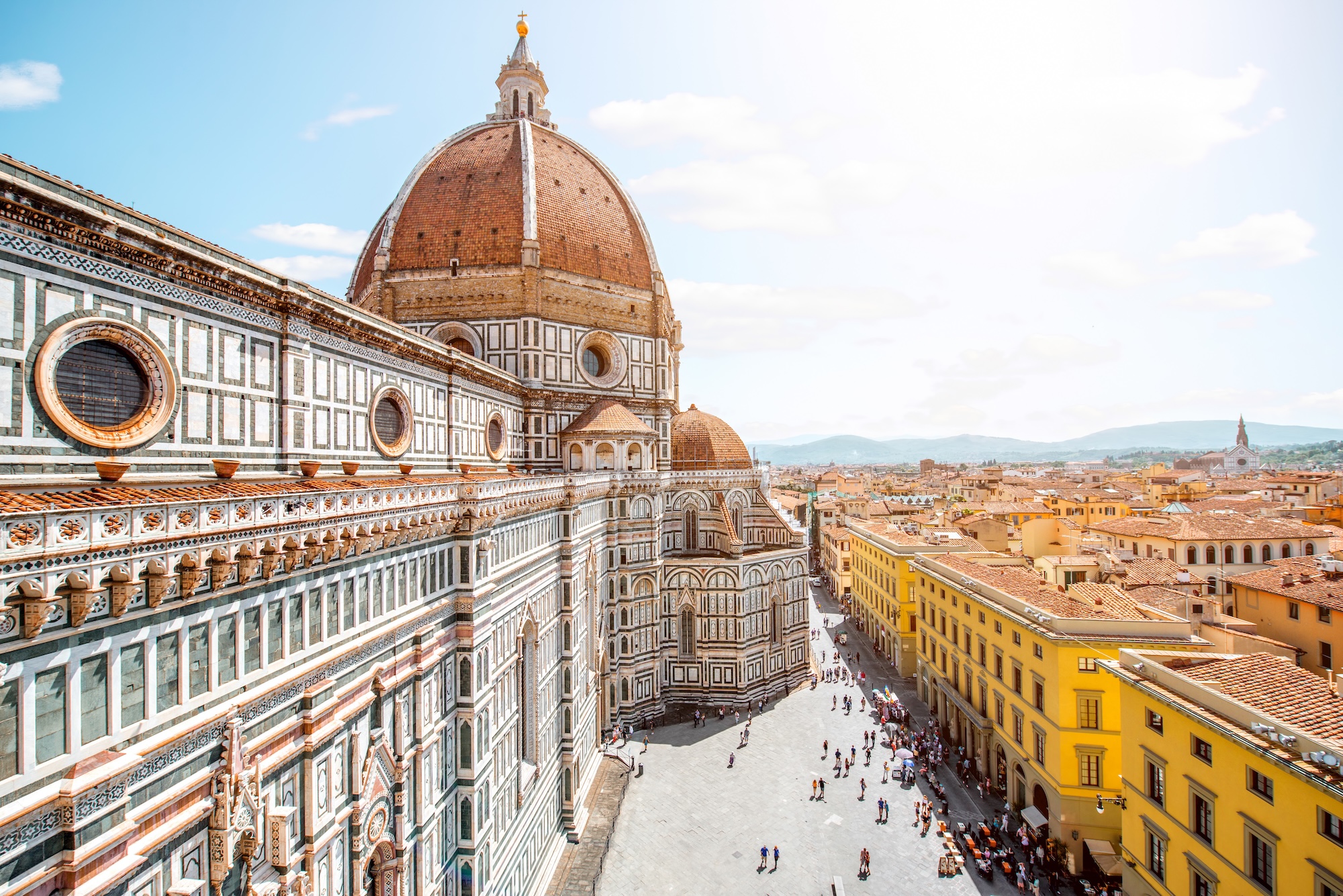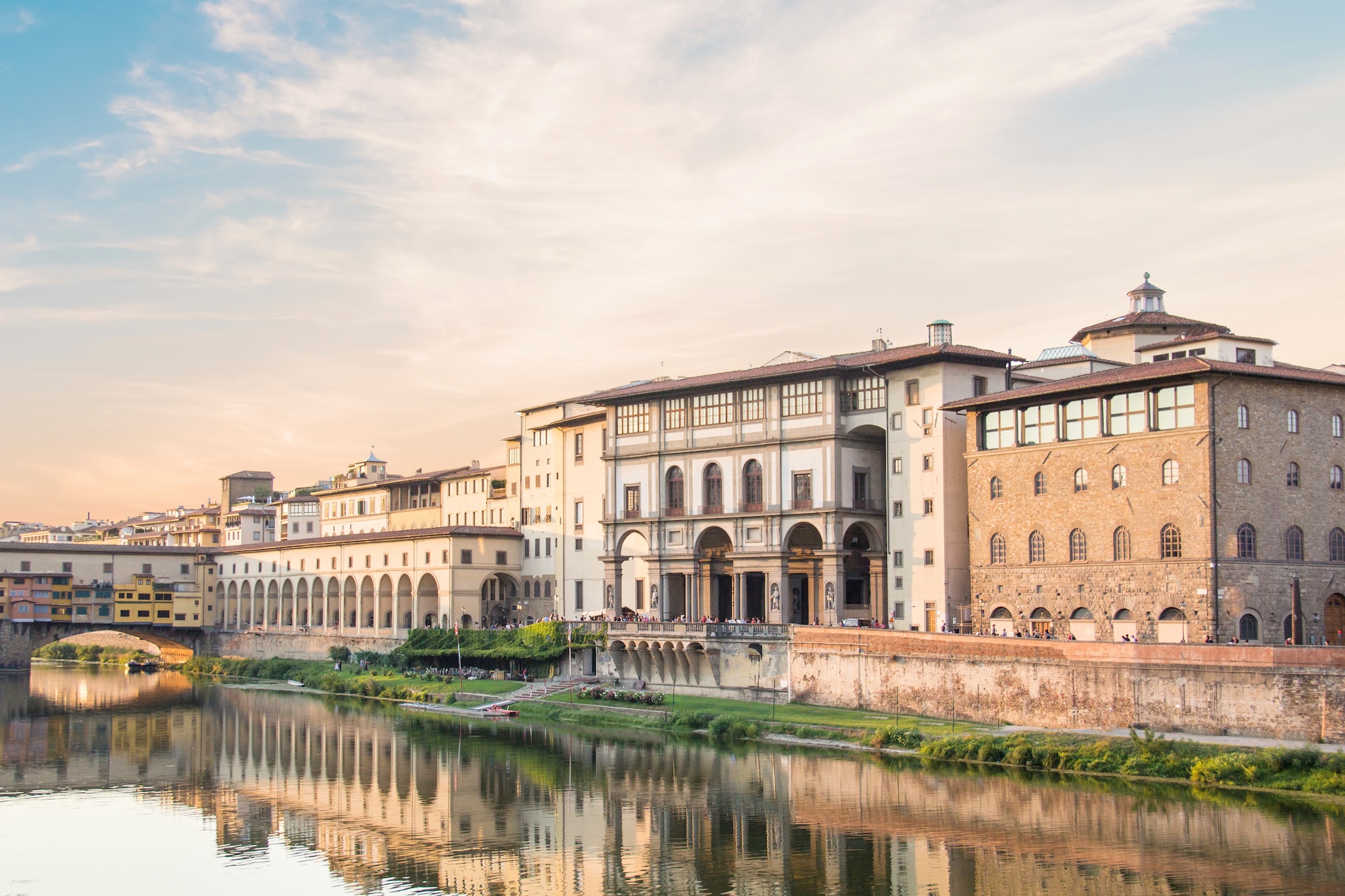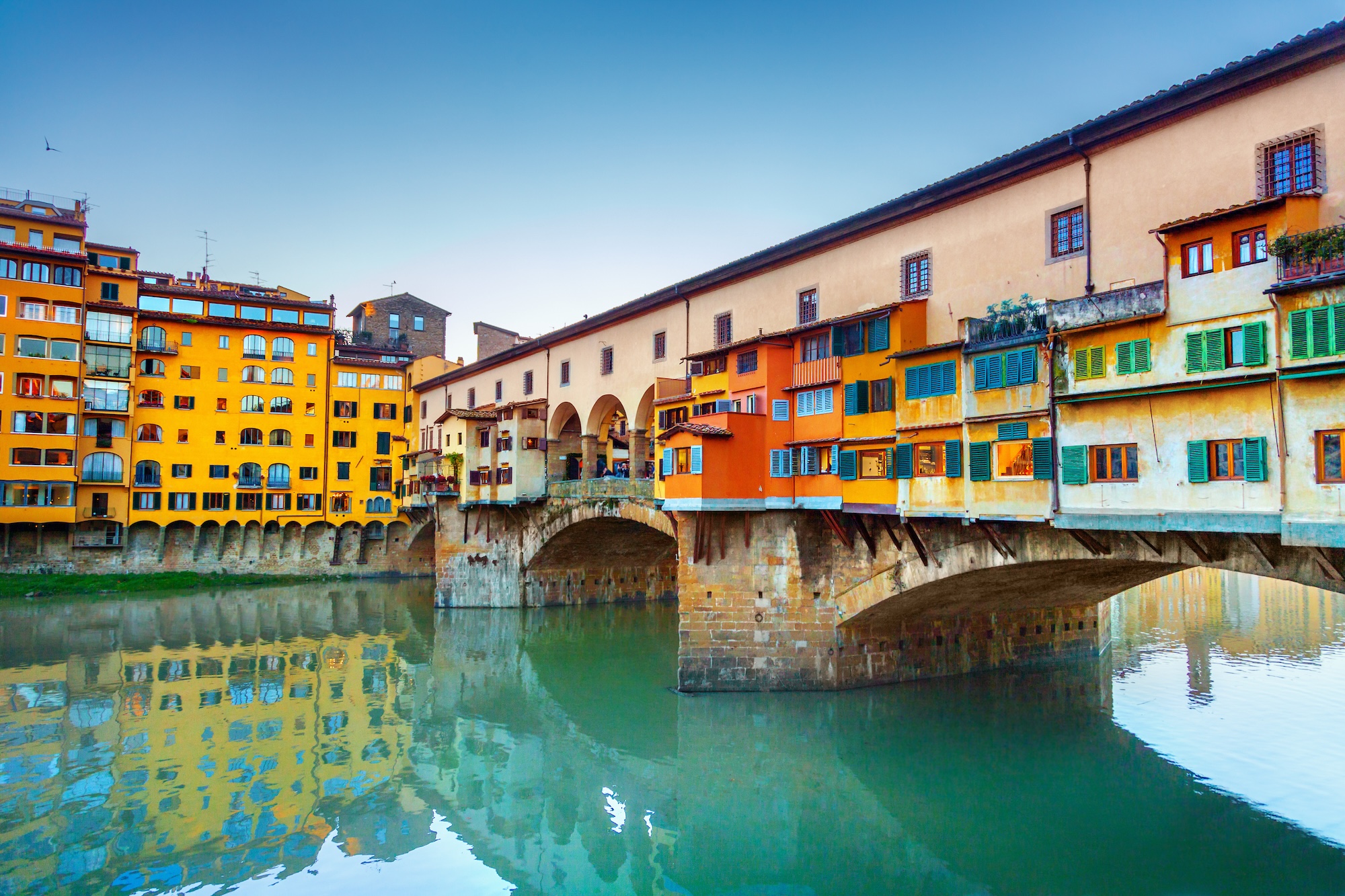
World Travel Tips
What Should You Do in Florence?
Florence, the cradle of the Renaissance, is a city of art, architecture, and timeless beauty. From awe-inspiring cathedrals to world-class museums and picturesque piazzas, Florence offers travelers an unforgettable journey through history and culture. Here are ten top attractions every visitor should consider:
1. Cathedral of Santa Maria del Fiore (Florence Duomo)

Dominating the city’s skyline, Cathedral of Santa Maria del Fiore, also known as the Duomo, is a masterpiece of Gothic architecture. Its striking red-tiled dome, designed by Brunelleschi, remains one of the greatest engineering feats of the Renaissance.
Why visit?
Climbing to the top of Florence Duomo rewards visitors with panoramic views of the city, while the interior stuns with beautiful frescoes and intricate marble work.
2. Uffizi Gallery

Home to one of the most important collections of Renaissance art in the world, the Uffizi Gallery showcases works by Botticelli, Michelangelo, Leonardo da Vinci, and many more. The museum itself is a historic building, originally constructed as offices for Florentine magistrates.
Why visit?
Art lovers shouldn’t miss the Uffizi Gallery—its halls house masterpieces that defined an era and influenced generations of artists.
3. Ponte Vecchio

Spanning the Arno River, Ponte Vecchio is Florence’s oldest and most famous bridge. Lined with charming jewelry shops and offering lovely river views, it’s an iconic symbol of the city.
Why visit?
Walking across the Ponte Vecchio feels like stepping into a storybook. The vibrant atmosphere and romantic views make it a favorite for visitors and photographers alike.
4. Galleria dell’Accademia
Best known as the home of Michelangelo’s “David,” the Galleria dell’Accademia is a must for anyone interested in Renaissance sculpture. The museum also displays paintings and musical instruments from Florence’s past.
Why visit?
Seeing Michelangelo’s David in person is an unforgettable experience, and the museum offers a deeper dive into Florentine artistry.
5. Piazzale Michelangelo
Perched on a hill across the river, Piazzale Michelangelo provides the best panoramic views of Florence. A replica of Michelangelo’s David stands in the center of this scenic square.
Why visit?
For breathtaking photos of the city, especially at sunset, Piazzale Michelangelo is unbeatable.
6. Basilica of Santa Croce
Known as the Temple of the Italian Glories, the Basilica of Santa Croce is the burial place of luminaries like Michelangelo, Galileo, and Machiavelli. The church’s neo-Gothic façade and stunning frescoes are highlights.
Why visit?
History buffs and art lovers can pay respects to Italy’s greats while exploring the beautiful interiors of Santa Croce.
7. Palazzo Vecchio
Once the seat of Florentine government, Palazzo Vecchio is a fortress-like palace overlooking Piazza della Signoria. Its grand rooms are filled with Renaissance art and historical artifacts.
Why visit?
Touring Palazzo Vecchio offers a glimpse into Florence’s political power and artistic achievements during the Renaissance.
8. Bargello Museum
Housed in a former medieval prison, the Bargello Museum features an outstanding collection of sculpture, including works by Donatello, Michelangelo, and other Renaissance masters.
Why visit?
The Bargello Museum is a hidden gem for sculpture enthusiasts and those fascinated by Florence’s turbulent history.
9. Boboli Gardens
Behind the Pitti Palace, the Boboli Gardens are a vast green oasis filled with fountains, statues, and manicured pathways. This open-air museum offers stunning city views and a peaceful retreat from busy streets.
Why visit?
Exploring the Boboli Gardens lets visitors enjoy art, history, and nature all at once, making it a delightful escape within the city.
10. Santa Maria Novella
Close to the main train station, Santa Maria Novella is a beautiful Dominican church known for its striking façade and remarkable frescoes by masters like Masaccio and Ghirlandaio.
Why visit?
Step inside Santa Maria Novella to discover one of Florence’s most artistically significant churches, filled with treasures from the early Renaissance.
Seasonal Recommendations
☀️ Summer (June–August): Summer is the peak travel season in Florence, bringing vibrant energy and long daylight hours. Temperatures usually range from 75°F to 90°F (24°C to 32°C), and the city’s lively piazzas fill with open-air concerts, festivals, and bustling cafés. While crowds are at their highest and lines at places like the Uffizi Gallery and Cathedral of Santa Maria del Fiore can be long, summer is perfect for enjoying sunset views from Piazzale Michelangelo or leisurely evenings along the Ponte Vecchio. Be prepared for heat and book popular attractions in advance.
🌸 Spring (March–May): Spring is a delightful time to visit Florence, as the city comes alive with blooming gardens and comfortable temperatures averaging 55°F to 75°F (13°C to 24°C). The lighter crowds make it easier to explore treasures like the Boboli Gardens or stroll through historic streets without the summer rush. Cafés spill out onto sidewalks, and the air is fresh, making it ideal for walking tours, enjoying art at the Bargello Museum, or relaxing in outdoor spaces.
🍁 Autumn (September–November): Autumn is a favorite for many travelers thanks to mild weather, golden light, and thinner crowds. With temperatures typically from 55°F to 75°F (13°C to 24°C), Florence’s streets feel less crowded and more relaxed. It’s an excellent season to take in city views from Piazzale Michelangelo, visit the Galleria dell’Accademia without long waits, or wander through food markets sampling seasonal Tuscan flavors. The city’s art, architecture, and culinary scene are at their cozy best.
❄️ Winter (December–February): Winter is the quietest season in Florence, with temperatures averaging 35°F to 55°F (2°C to 13°C). The festive period brings charming Christmas markets, lights, and fewer tourists at top attractions like the Palazzo Vecchio and Santa Maria Novella. Shorter days and cooler weather make this an ideal time to explore Florence’s world-class museums, sip hot chocolate in historic cafés, and enjoy the city’s intimate, magical side without the crowds.
Florence Excursions
Tips for Your Visit
Getting Around
- Walk the Historic Center: Florence’s main sights are close together, so walking is the best way to explore the city and enjoy its charming streets.
- Use Public Buses: The local ATAF buses are convenient for reaching areas outside the city center. Tickets can be bought at tobacco shops or bus stops.
- Avoid Driving: The historic center is a ZTL (limited traffic zone), and parking is expensive. Stick to walking or public transport within city limits.
Local Cuisine
- Try Florentine Steak: The famous “bistecca alla fiorentina” is a must-try dish—order it at a traditional trattoria for an authentic experience.
- Enjoy Gelato: Florence is known for artisan gelato. Look for shops displaying natural colors and serving gelato from covered metal tubs.
- Sample Street Eats: Don’t miss lampredotto (a local sandwich specialty) or schiacciata (Tuscan flatbread) from Florence’s food stalls.
Language
- Italian is Spoken: Italian is the main language, but English is widely understood in tourist areas, hotels, and restaurants.
- Learn Basic Phrases: A few words like “grazie” (thank you) and “per favore” (please) go a long way in making connections with locals.
Safety
- Beware of Pickpockets: Be especially vigilant around crowded attractions like the Ponte Vecchio and busy markets.
- Stay in Well-Lit Areas: Florence is generally safe, but stick to busy, well-lit streets at night and keep an eye on your belongings.
- Emergency Numbers: For emergencies, dial 112, the European emergency number, for police, medical, or fire assistance.
These tips will help you make the most of your Florence adventure, enjoy its incredible food, and stay safe as you explore this Renaissance gem!
3 Popular Restaurants
The restaurant scene in Florence, Italy, is a vibrant blend of tradition and innovation, reflecting the city’s deep culinary roots and creative spirit. From historic trattorias serving classic Tuscan fare to modern restaurants offering inventive twists on local dishes, Florence has something for every palate. Whether you’re looking for a romantic dinner, a taste of rustic authenticity, or a gourmet adventure, here are three popular and highly regarded restaurants in Florence.
1. Trattoria Mario
Location: Via Rosina, 2r, 50123 Firenze FI, Italy View On Map
Cuisine: Traditional Tuscan
Why It’s Popular: Trattoria Mario is a Florence institution known for its authentic, hearty Tuscan dishes and lively, communal atmosphere. Open since 1953, it’s beloved by both locals and travelers for its iconic bistecca alla fiorentina (Florentine steak), daily-changing menu, and wallet-friendly prices. Lunch only, no reservations—arrive early for a truly local experience.
2. La Giostra
Location: Borgo Pinti, 16R, 50121 Firenze FI, Italy View On Map
Cuisine: Tuscan & Italian (Upscale)
Why It’s Popular: La Giostra offers a magical, candle-lit dining experience in the heart of Florence. Known for its romantic setting, warm service, and refined takes on Tuscan classics like pear and pecorino ravioli and slow-cooked meats, it’s a favorite for special occasions. Complimentary prosecco and appetizers add to the memorable experience.
3. Osteria Vini e Vecchi Sapori
Location: Via dei Magazzini, 3/r, 50122 Firenze FI, Italy View On Map
Cuisine: Tuscan (Home-Style)
Why It’s Popular: Tucked near Piazza della Signoria, Osteria Vini e Vecchi Sapori is celebrated for its home-cooked, seasonally inspired dishes and welcoming, family-run vibe. The small menu focuses on regional recipes, like pappardelle with wild boar ragu and artichoke pie, and the intimate setting feels like dining at a friend’s table. Reservations are recommended due to its popularity and limited seating.
Tips for Dining in Florence
Florence is a culinary treasure trove where every meal is a chance to savor the flavors of Tuscany. From rustic trattorias to vibrant food markets and elegant rooftop restaurants, dining in Florence is an experience that blends history, tradition, and bold local flavors. These tips will help you eat well, order confidently, and enjoy the best of Florentine cuisine.
Important: Florence Tap Water is Safe to Drink
Tap water in Florence is safe, clean, and perfectly fine to drink. The city’s water supply is regularly tested and meets strict EU health standards, making it a safe option at restaurants and hotels.
Tip: Bottled water is widely available if you prefer it, but feel free to ask for tap water (“acqua del rubinetto”) at any eatery. When in doubt, check that your restaurant maintains clean facilities and follows health codes.
1. Reserve for Popular Restaurants
Florence is home to some of Italy’s most sought-after dining spots, from renowned trattorias to Michelin-starred venues. Tables can fill up quickly, especially for dinner.
Tip: Reserve in advance—online, by phone, or with your hotel’s help—to secure your spot, particularly at places like Trattoria Mario or La Giostra.
2. Try Local Specialties
Florentine cuisine is famous for its bold flavors and simplicity. Must-try dishes include bistecca alla fiorentina (Florentine steak), ribollita (Tuscan bread soup), and lampredotto (a traditional sandwich).
Tip: Don’t be shy about asking your server for recommendations or the day’s specials—many of the best local dishes never make it onto the printed menu.
3. Don’t Skip Aperitivo
Aperitivo—Florence’s beloved pre-dinner ritual—involves sipping a drink (like a spritz or Negroni) with complimentary snacks or a small buffet. It’s a perfect way to unwind and enjoy local flavors before dinner.
Tip: Try aperitivo at rooftop bars near the Duomo or cozy wine bars in Oltrarno for great views and authentic experiences.
4. Expect Leisurely Meals
Meals in Florence are meant to be enjoyed slowly, with multiple courses and plenty of conversation. Rushed service is rare, and dining is considered a social event.
Tip: Don’t expect your check automatically—ask for it (“Il conto, per favore”) when you’re ready to leave. Savor the slower pace and soak up the atmosphere.
5. Tipping is Appreciated, Not Required
Service is typically included in the bill, but leaving a small tip (5–10%) for good service is appreciated, especially in sit-down restaurants.
Tip: Rounding up your bill or leaving a couple of euros is a nice gesture. For quick bites or coffee, tipping isn’t necessary.
6. Enjoy the Markets
Florence’s food markets, like Mercato Centrale or Sant’Ambrogio, are bursting with local flavors, fresh produce, and delicious street food.
Tip: Sample local cheeses, salumi, and fresh pastries—or grab a quick, budget-friendly meal from one of the market’s food stalls.
7. Embrace Seasonal Eating
Florentines take pride in eating with the seasons. Menus often change to feature fresh, local ingredients—think wild boar in autumn, artichokes in spring, or truffles in winter.
Tip: Ask about seasonal specials, and don’t miss the chance to try ingredients at their freshest.
8. Look for Authentic Trattorias
For a truly local meal, avoid tourist traps near major landmarks and seek out family-run trattorias in quieter neighborhoods.
Tip: Authentic spots usually feature hand-written menus, local wine, and a welcoming, unpretentious vibe.
9. Understand Italian Dining Hours
Florence restaurants typically serve lunch from 12:30 to 2:30 PM and dinner from 7:30 to 10:30 PM. Many spots close between lunch and dinner, so plan accordingly.
Tip: If you’re hungry between meal times, try a panini shop or gelateria, which often stay open throughout the afternoon.
10. Enjoy Gelato Like a Local
Florence is the birthplace of gelato, and no visit is complete without sampling some. The best gelaterias use natural ingredients and display their gelato in covered metal tubs, not towering mounds.
Tip: Look for shops advertising “artigianale” (artisanal) gelato and avoid places with bright, artificial colors.
Conclusion
Dining in Florence is more than just a meal—it’s an essential part of experiencing the city’s culture and heritage. With these tips, you’ll eat like a local, discover unforgettable flavors, and enjoy every moment at the table in one of Italy’s most delicious destinations. Buon appetito!








